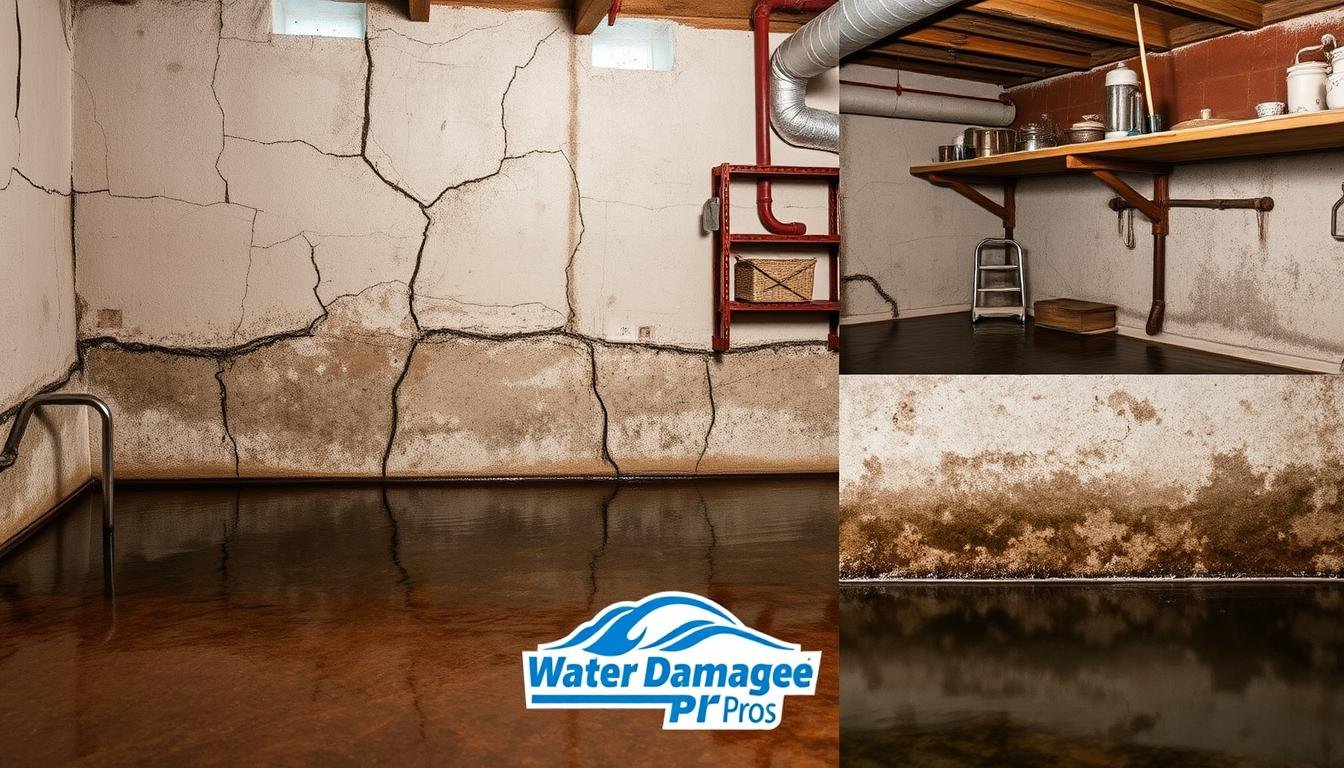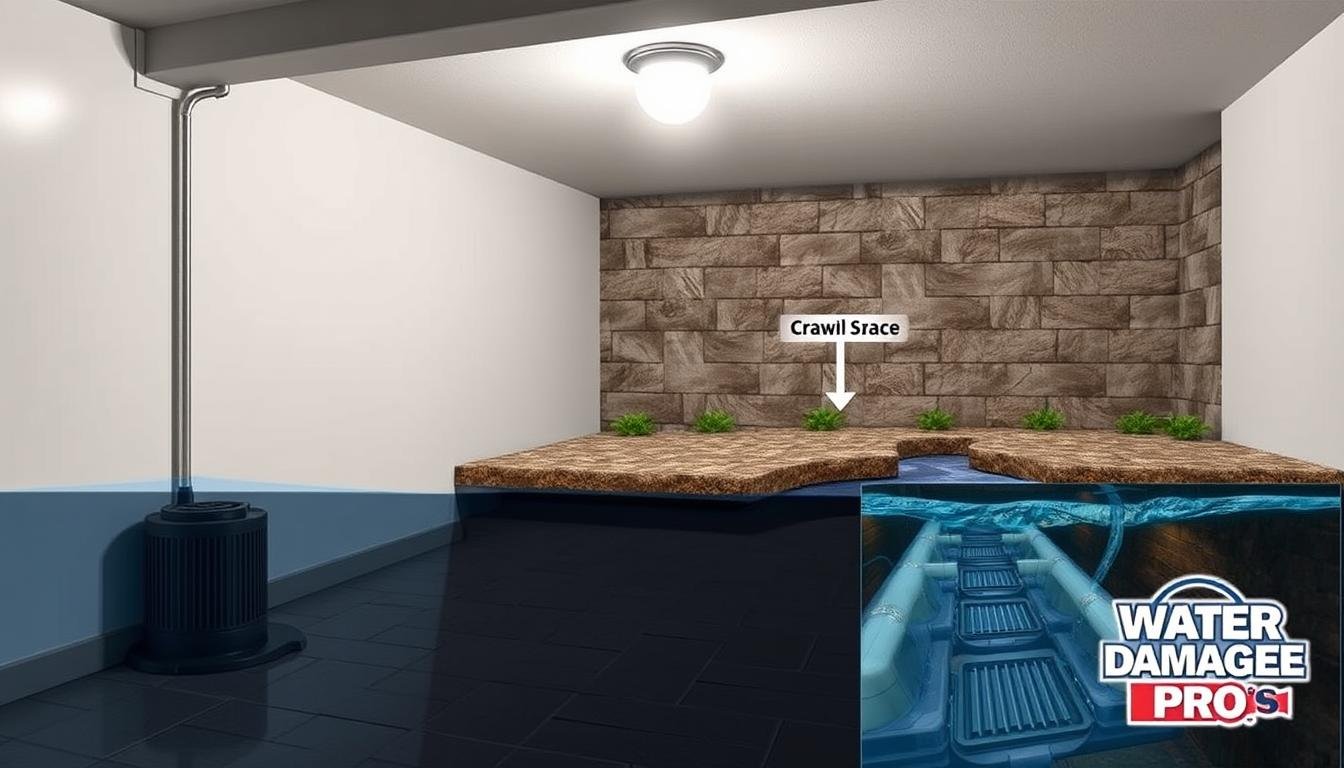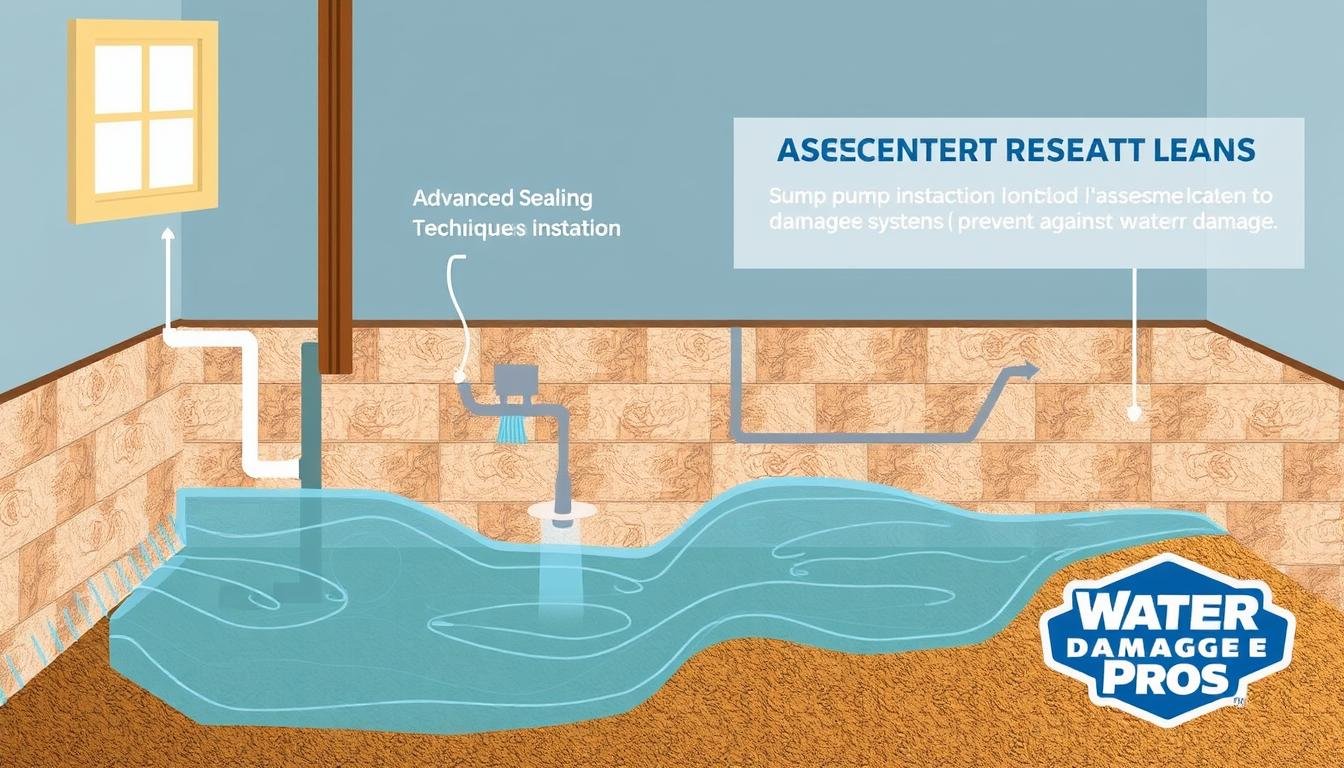Common Causes of Basement Water Damage and How to Solve Them
Did you know that just one inch of rain can dump over 1,250 gallons of water on a 2,000-square-foot house roof1? This shows how much water can flood your basement. Basement water damage can lead to mold, bad smells, and damage to your stuff, floors, and walls. It’s key to find and fix the main causes of basement water problems to keep your space dry and healthy. Surface water and groundwater are the main reasons for basement water damage2. Water pressure from rising groundwater can push through cracks in your foundation2. On the surface, issues like leaky windows, clogged window wells, and overflowing gutters can let water in2. Even a broken pipe or a damaged washing machine hose can flood your basement2. State Farm and Forbes say five main reasons for basement flooding are surface water, water pressure, storm sewer backups, clogged sewers, and bad weather3. To fix these problems, you need to improve drainage, install or replace sump pumps, and add interior drainage systems2. You also need to protect against plumbing leaks2. Key Takeaways Basement water damage can be caused by surface water and subsurface groundwater issues. Common causes include hydrostatic pressure, leaky windows, clogged gutters, and plumbing problems. Effective solutions involve improving drainage, installing sump pumps, and addressing foundation cracks. Hiring professional basement waterproofing experts can provide long-lasting solutions. Regular maintenance and inspections can help prevent future basement water problems. Identifying the Source of Basement Water Damage Basement water damage can lead to mold, wood rot, flooding, and damage to stored items4. Finding where the water is coming from is key. Surface water that doesn’t drain right is often the problem. Surface Water Leaking into Basement Leaky windows, clogged window wells, and overflowing gutters are common issues4. Downspouts that don’t reach far enough and poor landscape slope also cause problems4. These can make walls damp, cause musty smells, and lead to mold5. Fixing these problems can stop water from getting into the basement4. Other causes include plumbing leaks, high humidity, and foundation or sump pump issues5. Knowing the cause helps find the right fix to keep the basement dry6. Regular checks and upkeep are vital to fight basement moisture5. By tackling the water source, homeowners can save their property’s value and keep it dry6. Basement Water Damage Solutions Fixing basement water damage needs a few steps. A good sump pump system, like the TripleSafe from Basement Systems, keeps water out7. An interior drainage system, like WaterGuard, catches water before it hits the floor7. Replacing old water heaters and supply lines stops leaks7. It’s also key to fix foundation cracks and get rid of mold or mildew7. Dehumidification is crucial for a dry basement. ServiceMaster Restore® uses special equipment to dry out basements7. They also suggest installing drainage systems to avoid water pressure7. ServiceMaster Restore® talks to customers and insurance companies to handle claims7. With over 65 years of experience, they’re the top choice for customers7. Basement Water Damage Solutions Benefits Sump Pump Installation Reliable protection against basement flooding Interior Drainage Systems Capture water before it reaches the basement floor Plumbing Leak Prevention Stop major basement flooding Foundation Crack Repair Maintain a dry, healthy basement environment Dehumidification Thorough water damage restoration Proper Drainage Systems Prevent hydrostatic pressure issues Dealing with basement water damage quickly and fully is key. These solutions help keep homes safe, prevent damage, and keep basements dry8. “Basement water damage is one of the leading causes of home insurance claims, with millions of dollars in damages incurred annually. Most homeowners with basements will likely experience some form of water damage at some point.” 8 Conclusion Fixing basement waterproofing is key to keep your home safe and your belongings dry. Finding where the water comes from and fixing it right can stop expensive damage. This keeps your basement dry and healthy9. Using the right solutions, like interior drainage and sump pumps, helps a lot. These steps not only fix current problems but also protect your home’s value and structure for the future. Acting early to stop water damage prevention is a smart move. It keeps your property safe and gives you peace of mind910. Even if insurance covers some damage, fixing a flooded basement can still cost a lot10. It’s wise to talk to a professional restoration company. They can handle the problem safely and prevent more damage. Fixing basement water damage also makes your home healthier and more comfortable. 910, Regular checks and upkeep, along with preventive steps, are crucial. They help protect your biggest investment – your home. FAQ What are the common causes of water in the basement? Water in the basement usually comes from two main sources. Surface water problems include leaky windows, clogged window wells, and overflowing gutters. Short downspouts and poor landscape slope also play a role. Additionally, settled pavement can cause issues. Subsurface groundwater problems arise from hydrostatic pressure. This pressure pushes against the foundation, causing water to seep through cracks and openings in the concrete. How can I identify the source of the water in my basement? Finding the source of basement water is the first step to fixing it. Look for signs of surface water problems like leaky windows and clogged window wells. Also, check for overflowing gutters and poor landscape slope. For subsurface groundwater, watch for foundation cracks and water seeping through walls. These signs can help you pinpoint the problem. What are some effective solutions for basement water damage? To prevent and fix basement water damage, consider a few solutions. Installing a reliable sump pump system is a good start. An interior drainage system can also capture water before it hits the basement floor. Protecting against plumbing leaks and repairing foundation cracks are also important. Adding insulation to prevent condensation is another step. Lastly, address any mold or mildew issues promptly. Why is it important to address basement water damage? Fixing basement water damage is key to protecting your home and belongings. Water can cause mold, musty smells, and damage to walls and floors. It …
Continue reading “Common Causes of Basement Water Damage and How to Solve Them”





